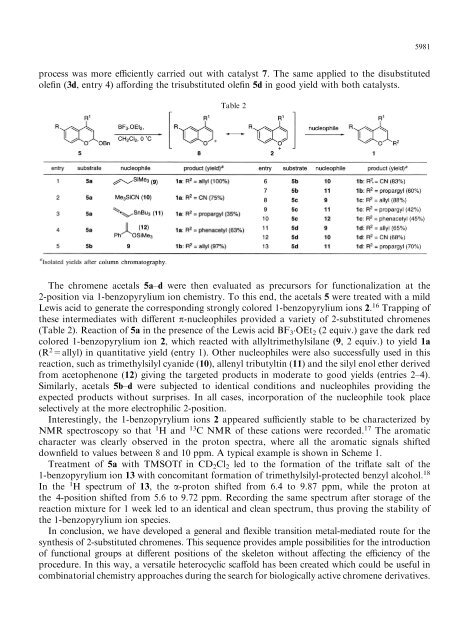Synthesis of 2-substituted chromenes via ring-closing metathesis ...
Synthesis of 2-substituted chromenes via ring-closing metathesis ...
Synthesis of 2-substituted chromenes via ring-closing metathesis ...
- No tags were found...
Create successful ePaper yourself
Turn your PDF publications into a flip-book with our unique Google optimized e-Paper software.
5981<br />
process was more eciently carried out with catalyst 7. The same applied to the di<strong>substituted</strong><br />
ole®n (3d, entry 4) a€ording the tri<strong>substituted</strong> ole®n 5d in good yield with both catalysts.<br />
Table 2<br />
The chromene acetals 5a±d were then evaluated as precursors for functionalization at the<br />
2-position <strong>via</strong> 1-benzopyrylium ion chemistry. To this end, the acetals 5 were treated with a mild<br />
Lewis acid to generate the corresponding strongly colored 1-benzopyrylium ions 2. 16 Trapping <strong>of</strong><br />
these intermediates with di€erent p-nucleophiles provided a variety <strong>of</strong> 2-<strong>substituted</strong> <strong>chromenes</strong><br />
(Table 2). Reaction <strong>of</strong> 5a in the presence <strong>of</strong> the Lewis acid BF 3<br />
.OEt 2 (2 equiv.) gave the dark red<br />
colored 1-benzopyrylium ion 2, which reacted with allyltrimethylsilane (9, 2 equiv.) to yield 1a<br />
(R 2 =allyl) in quantitative yield (entry 1). Other nucleophiles were also successfully used in this<br />
reaction, such as trimethylsilyl cyanide (10), allenyl tributyltin (11) and the silyl enol ether derived<br />
from acetophenone (12) giving the targeted products in moderate to good yields (entries 2±4).<br />
Similarly, acetals 5b±d were subjected to identical conditions and nucleophiles providing the<br />
expected products without surprises. In all cases, incorporation <strong>of</strong> the nucleophile took place<br />
selectively at the more electrophilic 2-position.<br />
Interestingly, the 1-benzopyrylium ions 2 appeared suciently stable to be characterized by<br />
NMR spectroscopy so that 1 H and 13 C NMR <strong>of</strong> these cations were recorded. 17 The aromatic<br />
character was clearly observed in the proton spectra, where all the aromatic signals shifted<br />
down®eld to values between 8 and 10 ppm. A typical example is shown in Scheme 1.<br />
Treatment <strong>of</strong> 5a with TMSOTf in CD 2 Cl 2 led to the formation <strong>of</strong> the tri¯ate salt <strong>of</strong> the<br />
1-benzopyrylium ion 13 with concomitant formation <strong>of</strong> trimethylsilyl-protected benzyl alcohol. 18<br />
In the 1 H spectrum <strong>of</strong> 13, the a-proton shifted from 6.4 to 9.87 ppm, while the proton at<br />
the 4-position shifted from 5.6 to 9.72 ppm. Recording the same spectrum after storage <strong>of</strong> the<br />
reaction mixture for 1 week led to an identical and clean spectrum, thus proving the stability <strong>of</strong><br />
the 1-benzopyrylium ion species.<br />
In conclusion, we have developed a general and ¯exible transition metal-mediated route for the<br />
synthesis <strong>of</strong> 2-<strong>substituted</strong> <strong>chromenes</strong>. This sequence provides ample possibilities for the introduction<br />
<strong>of</strong> functional groups at di€erent positions <strong>of</strong> the skeleton without a€ecting the eciency <strong>of</strong> the<br />
procedure. In this way, a versatile heterocyclic sca€old has been created which could be useful in<br />
combinatorial chemistry approaches du<strong>ring</strong> the search for biologically active chromene derivatives.
















